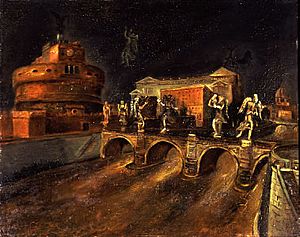Scipione (Gino Bonichi) facts for kids
Gino Bonichi (born February 25, 1904 – died November 9, 1933), known as Scipione, was a talented Italian painter and writer. He is remembered for his unique artistic style.
Scipione was born in Macerata, Italy. In 1909, he moved to Rome, where he later studied art at the Scuola Libera di Nudo, a free art school. He, along with Mario Mafai and Antonietta Raphael, started an art group called the Scuola romana (Roman School). These artists were based in Rome and were inspired by a style called Expressionism. They wanted to create art that was different from the official art approved by the government at the time.
Scipione first showed his artwork in public in 1927. Around the same time, he also began to publish his poems and essays.
About His Art
Scipione loved art history and studied the works of famous Italian old masters. He also looked at artists like El Greco and Goya for inspiration. Other Expressionist painters, such as Chaïm Soutine, James Ensor, and George Grosz, also helped shape his artistic style.
His art often showed a sense of mystery and used personal symbols. He combined ideas from symbolism, surrealism, and expressionism. This helped him create paintings that had a strong emotional impact. He used bright, vivid colors and sometimes distorted (changed) the shapes of people or objects in his paintings.
Scipione was most active between 1927 and the autumn of 1930. During these years, he created some of his most important works. These include Still-life with a Bowler Hat (1929) and Still-life with a Feather (1929).
Later Life and Legacy
Scipione showed his art at important exhibitions, including the Venice Biennale in 1930 and the first Rome Quadriennale in 1931.
For the last two years of his life, Scipione suffered from tuberculosis, a serious illness. This made it difficult for him to paint, so he focused more on drawing. He passed away in Arco on November 9, 1933, at a young age.
His nephew, Claudio Bonichi, who was born in 1943, also became a painter, continuing the family's artistic legacy.
See also
 In Spanish: Scipione (artista) para niños
In Spanish: Scipione (artista) para niños


